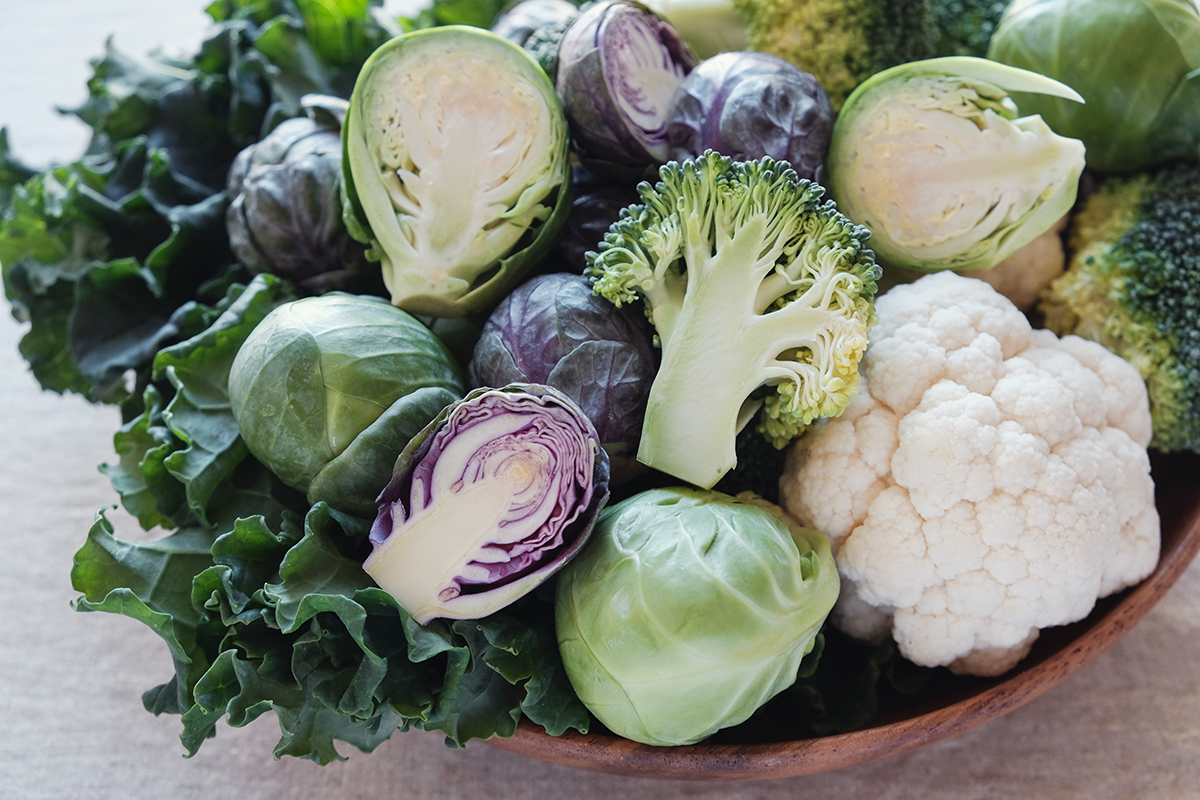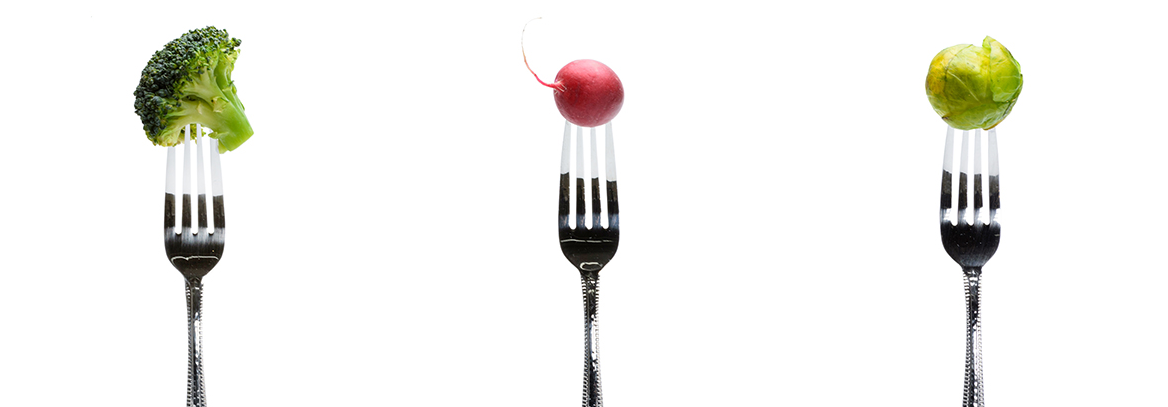Looking for the most powerful cancer-fighting vegetables on the planet? Then feast your eyes (and of course, your body) on the plant foods that have demonstrated the most dramatic protection against cancer: the cruciferous family of vegetables.
What are cruciferous vegetables?
With their spicy, sometimes bitter taste (thanks to their glucosinolate content – more on that later), cruciferous vegetables add a depth of flavor to a healthy diet, in addition to their beneficial properties. The list of cruciferous veggies includes: arugula, bok choy, broccoli, broccoli rabe, broccolini, brussels sprouts, cabbage, cauliflower, collards, horseradish, kale, kohlrabi, mustard greens, radish, red cabbage, rutabaga, turnips, turnip greens, and watercress.

What makes cruciferous vegetables so special?
The cruciferous family is unique among vegetables because of their glucosinolate content. When the plant cell walls are disrupted by chewing, chopping, or blending, the enzyme myrosinase converts glucosinolates to isothiocyanates (ITCs) or indole-3-carbinol. Scientific studies have uncovered cellular and molecular anti-cancer effects of these cruciferous phytochemicals, and a lower risk of cancer in people who eat these vegetables regularly.
How to prepare & eat them
To get the maximum benefit from cruciferous vegetables, it’s important to make sure you chop finely, blend, or crush them before you cook them, or chew them well when eating them. That’s because the myrosinase enzyme is physically separated from the glucosinolates in the intact vegetables. But when the plant cells are broken apart, the chemical reaction occurs and ITCs are formed. The more cells you break open before cooking (or chew if you are eating the vegetables raw), the better.
Once ITCs are formed, they will remain stable through the cooking process. Gut bacteria also have some myrosinase enzyme, so additional ITC production from glucosinolates in cooked cruciferous vegetables may occur after we eat them. Also, we can increase ITC production from cooked cruciferous vegetables by having some shredded raw cruciferous vegetables such as cabbage, kale, collards or arugula in a salad in the same meal to supply the myrosinase enzyme, which the body can use during the digestive process.(1-3)
Reduced risk of cancer in cruciferous consumers
Higher intake of cruciferous vegetables is linked to a reduced risk of cancers of the lung, ovary, stomach, breast, prostate, and colon.(4-8)

How cruciferous phytochemicals work(9,10)
- Anti-inflammatory effects: ITCs have been found to decrease the secretion of inflammatory molecules.
- Anti-angiogenic effects: Isothiocyanates can inhibit the development of new blood vessels to limit tumor growth.
- Detoxification of carcinogens: Some carcinogens must be converted to their active form before they can bind DNA to cause carcinogenic changes – isothiocyanates inhibit this transformation.
- Preventing DNA damage: Isothiocyanates also increase the production of our body’s natural detoxification enzymes, which protect DNA against damage from carcinogens and free radicals.
- Stopping cell division in cells whose DNA has been damaged.
- Preventing proliferation and promoting programmed cell death in cancerous cells
- Stimulating interferon production: Diindolylmethane (DIM), formed from indole-3-carbinol, stimulates interferon production, which is part of the body’s antiviral and anti-tumor response.
- Anti-estrogenic activity: Exposure to estrogen is known to increase breast cancer risk; estrogens can alter gene expression, promoting cell proliferation breast tissue. ITCs and indole-3-carbinol have been shown to inhibit the expression of estrogen-responsive genes.
- Shifting hormone metabolism: Eating cruciferous vegetables regularly helps the body to shift hormone metabolism, reducing the cancer-promoting potency of estrogen and other hormones.
Anti-estrogenic effects of cruciferous vegetables
Indole-3-carbinol (abundant in broccoli, Brussels sprouts and cabbage) and ITCs have anti-estrogenic effects, help the body excrete estrogen and other hormones.(11) In fact, new research has shown additional anti-estrogenic effects of both indole-3-carbinol and sulforaphane (most abundant in broccoli); these ITCs blunt the growth-promoting effects of estrogen on breast and cervical cancer cells.(11-13)
Studies have found breast cancer survivors who eat cruciferous vegetables regularly have a lower likelihood of cancer recurrence.(14, 15)
Cruciferous vegetables in randomized controlled trials
In healthy people, randomized controlled trials have found decreases in oxidative stress or increases in antioxidant enzymes after consumption of cruciferous vegetables.(16-19)
Reduced cancer-related biomarkers have been found in randomized controlled trials on supplementation with cruciferous vegetables or their extracts in patients with prostate cancer or breast cancer.(20-23)
Article originally printed on DrFuhrman.com. Reprinted with permission from Dr. Fuhrman.
Joel Fuhrman, MD is a board-certified family physician specializing in nutritional medicine. He is President of the Nutritional Research Foundation and the author of 7 New York Times bestselling books, including his most recent book, “Eat to Live”. Visit his website, DrFuhrman.com.
References
- Oliviero T, Verkerk R, Dekker M. Isothiocyanates from Brassica Vegetables-Effects of Processing, Cooking, Mastication, and Digestion. Mol Nutr Food Res 2018, 62:e1701069.
- Wu Y, Shen Y, Wu X, et al. Hydrolysis before Stir-Frying Increases the Isothiocyanate Content of Broccoli. J Agric Food Chem 2018, 66:1509-1515.
- Conaway CC, Getahun SM, Liebes LL, et al. Disposition of glucosinolates and sulforaphane in humans after ingestion of steamed and fresh broccoli. Nutr Cancer 2000, 38:168-178.
- Zhang Z, Bergan R, Shannon J, et al. The Role of Cruciferous Vegetables and Isothiocyanates for Lung Cancer Prevention: Current Status, Challenges, and Future Research Directions. Mol Nutr Food Res 2018, 62:e1700936.
- Hu J, Hu Y, Hu Y, Zheng S. Intake of cruciferous vegetables is associated with reduced risk of ovarian cancer: a meta-analysis. Asia Pac J Clin Nutr 2015, 24:101-109.
- Wu QJ, Yang Y, Vogtmann E, et al. Cruciferous vegetables intake and the risk of colorectal cancer: a meta-analysis of observational studies. Ann Oncol 2013, 24:1079-1087.
- Wu QJ, Yang Y, Wang J, et al. Cruciferous vegetable consumption and gastric cancer risk: a meta-analysis of epidemiological studies. Cancer Sci 2013, 104:1067-1073.
- Liu X, Lv K. Cruciferous vegetables intake is inversely associated with risk of breast cancer: a meta-analysis. Breast 2013, 22:309-313.
- Higdon J, Delage B, Williams D, Dashwood R. Cruciferous vegetables and human cancer risk: epidemiologic evidence and mechanistic basis. Pharmacological Research 2007, 55:224-236.
- Xue L, Pestka JJ, Li M, et al. 3,3′-Diindolylmethane stimulates murine immune function in vitro and in vivo. J Nutr Biochem 2008, 19:336-344.
- Yuan F, Chen DZ, Liu K, et al. Anti-estrogenic activities of indole-3-carbinol in cervical cells: implication for prevention of cervical cancer. Anticancer Research 1999, 19:1673-1680.
- Meng Q, Yuan F, Goldberg ID, et al. Indole-3-carbinol is a negative regulator of estrogen receptor-alpha signaling in human tumor cells. Journal of Nutrition 2000, 130:2927-2931.
- Ramirez MC, Singletary K. Regulation of estrogen receptor alpha expression in human breast cancer cells by sulforaphane. J Nutr Biochem 2009, 20:195-201.
- Nechuta SJ, Lu W, Cai H, et al: Cruciferous Vegetable Intake After Diagnosis of Breast Cancer and Survival: a Report From the Shanghai Breast Cancer Survival Study. Abstract #LB-322. In Annual Meeting of the American Association for Cancer Research; 2012 Mar 31-Apr 4. Chicago, Il2012.
- Thomson CA, Rock CL, Thompson PA, et al. Vegetable intake is associated with reduced breast cancer recurrence in tamoxifen users: a secondary analysis from the Women’s Healthy Eating and Living Study. Breast Cancer Research and Treatment 2011, 125:519-527.
- Murashima M, Watanabe S, Zhuo XG, et al. Phase 1 study of multiple biomarkers for metabolism and oxidative stress after one-week intake of broccoli sprouts. Biofactors 2004, 22:271-275.
- Verhagen H, Poulsen HE, Loft S, et al. Reduction of oxidative DNA-damage in humans by brussels sprouts. Carcinogenesis 1995, 16:969-970.
- Riso P, Martini D, Visioli F, et al. Effect of broccoli intake on markers related to oxidative stress and cancer risk in healthy smokers and nonsmokers. Nutr Cancer 2009, 61:232-237.
- Gill CI, Haldar S, Boyd LA, et al. Watercress supplementation in diet reduces lymphocyte DNA damage and alters blood antioxidant status in healthy adults. Am J Clin Nutr 2007, 85:504-510.
- Alumkal JJ, Slottke R, Schwartzman J, et al. A phase II study of sulforaphane-rich broccoli sprout extracts in men with recurrent prostate cancer. Invest New Drugs 2015, 33:480-489.
- Cipolla BG, Mandron E, Lefort JM, et al. Effect of Sulforaphane in Men with Biochemical Recurrence after Radical Prostatectomy. Cancer Prev Res (Phila) 2015, 8:712-719.
- Traka M, Gasper AV, Melchini A, et al. Broccoli consumption interacts with GSTM1 to perturb oncogenic signalling pathways in the prostate. PLoS One 2008, 3:e2568.
- Wirth MD, Murphy EA, Hurley TG, Hebert JR. Effect of Cruciferous Vegetable Intake on Oxidative Stress Biomarkers: Differences by Breast Cancer Status. Cancer Invest 2017, 35:277-287.
